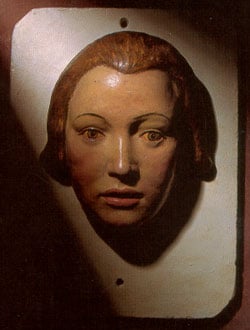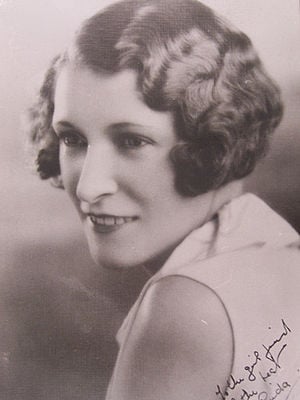The Pyjama Girl Murder Mystery
A Body on the Road
Every now and then an intriguing crime captivates public imagination, so that it is never completely forgotten, no matter how much time goes by. The Pyjama Girl mystery is one such case - an unsolved murder that stretches back over 70 years, to 1934.
On the first day of
Spring of that year, a young woman's body was found beside a lonely
road in Albury, a country border town between NSW and Victoria,
Australia. The body was not visible to any passing traffic as it was
lying under a culvert. A man named Tom Griffith had discovered it purely
by chance as he was leading his prize bull along the side of the road.
Stopping for a cigarette, he saw, in his own words, 'a peculiar looking
bundle' and went to investigate.
The woman had been bashed, shot and partially burnt, making identification difficult. She was small, beautiful, blue-eyed and in her 20's but that's all there was to identify her, apart from her green silk pyjamas. Her body had been shoved face first into a hessian bag and set alight. The bullet had penetrated just under her right eye but later the coroner would determine that the real cause of death had been eight vicious blows to her face.

Exotic Pyjamas
In the 1930s pyjamas were not commonly worn by women - they were considered strange and risque and generally only worn by partying 'flappers' who smoked, drank and wore revealing outfits - at least, that was the public impression. As a result the Pyjama Girl was held up as an example of what can happen to worldly women whose chief concern is to enjoy themselves.
This, together with the brutality of the murder and the ongoing mystery of the woman's identity ensured high press coverage and theories and speculations saturated the papers. Missing peoples files were checked and re-checked, artist's impressions were published in every newspaper and police made masks, photographed them and circulated the images. No result. A worldwide search was launched but, as was reported in the newsreels of the day....." back from the great cities and tiny outposts of the world came the reply, "no untraced woman answering to your description is missing from this country." Frustrated and no closer to solving the Pyjama Girl's mysterious identity, the police took the extraordinary and unprecedented step of preserving her body in a formalin bath - and there she remained for ten long years.
Public Viewing
The public were invited to view the body in the hope that someone would recognize the murdered girl. Hundreds passed through, though many came out wishing they hadn't - from all reports it was a disturbing sight. Due to the widespread press coverage and subsequent public interest, there was a constant pressure on the police comissioner to solve the crime. The commissioner, Bill Mackay, became obsessed with case - the police now had a short list of missing girls and a young woman called Linda Agostini was at the top of that list.
Agostini was an English woman who had worked as a hairdresser aboard a cruise ship, before marrying an Italian, Antonio Agostini, who, when questioned by police claimed his wife had deserted him. The police were unconviced by Agostini's story but the physical description of Linda did not correspond with the Pyjama Girl. For a start, the dental records didn't match, Linda had brown eyes not blue and her breasts were full, not small and round like the Pyjama Girl's.Thus she was eventually crossed off the list. The police were back where they started, with an unsolved crime.

Ten Years On
By an extraordinary coincidence, Bill Mckay used to frequent an elite Sydney restaurant, Romano's, where Antonio Agnostini happened to work as a waiter. In a scene that would stretch the credulity of any crime fiction fan, Mackay claimed that one evening in the restaurant he noticed Agostini looking particularly unhappy and inquired as to why. In response Agostini broke down and confessed that he was now a miserable widower because he had killed his wife Linda ten years before. The police commissioner was elated and announced to the world that he had solved the Pyjama Girl mystery. It was all so pat, neat and remarkably simple - how extraordinary that ten years after the event, the crime should be solved in this fashion.
Mackay's pronouncement was accepted and the case was filed. Yet there were many aspects that just didn't quite add up. There were the dental records, which at the time of the murder had been compared to Linda Agostini's and declared a mismatch. Agostini had had porcelain fillings that three dental experts had failed to find on the corpse, yet when Mackay ordered dental expert Professor Everett Magnus to re-examine the corpe's teeth ten years later, they miraculously appeared.
Then there was the question of the Pyjama Girls eyes, which were blue. Linda's were brown. At the coronial inquiry, police calleld two expert witneses who testified that the eyes must have turned brown after death - a phenomenum that is, according to most forensic scientists, extremely unlikely - yet it was accepted by the coroner.
There were other anomalies too. According to his confession, Antonio Agnostini claimed he had shot his wife by accident when she was threatening him with a gun and then put her in a bag and drove to the country. He then claimed to have poured petrol over his wife's body and used up the remainder in the can to drive back to Melbourne. However, Sergeant Kelly who was among those on the scene when the body was found, had reported smelling a strong odour of kerosine, not petrol. Just prior to the coronial inquiry he changed this report to 'I smelt kerosine or petrol'. In addition, Agostini made no mention in his confession of the blows inflicted on the Pyjama Girl. Later he came up with a far-fetched story about her having fallen down the stairs, which was not consistent with the forensic evidence
An Alternative Theory
Historian Richard Evans, who has studied all the original police records and court documents believes the Pyjama Girl was not Linda Agostini. Was Mackay so desperate to solve the case he fudged evidence and made a deal with Agostini? Evans believes so. Agostini did kill his wife but she was not the Pyjama Girl.It seems likely Mackay threatened to send Agostini to the gallows for the murder of his real wife if he didn't play ball. If he confessed to the Albury murder he would only be charged with manslaughter but if he did not, he would face execution. Later, after his conviction, Agostini claimed he did not murder the girl whose body was uncovered in Albury, although he never denied he had killed his real wife. What happened to her is still a mystery. After serving three years of a six year term for manslaughter he was deported to Italy.
When the Pyjama Girl's body was finally laid to rest, ten years after her murder, Agostini refused to pay for the funeral because, as he said at the time... "she was not my wife".
So Who was the Pyjama Girl?
If not Linda Agostini, who was the real Pyjama Girl? Why didn't anyone ever come forward to identify her? Why would a beautiful, sexy young woman lay unclaimed for so very long? Who was really responsible for her murder?
These questions remain unanswered and until they are, the image of the Pyjama Girl will continue to haunt.
- The Beaumont Children
When a child disappears, it is a parent's nightmare realised - but when three disappear from the same family all at the same time, it is an unimaginable tragedy beyond even nightmares. Yet that is exactly what... - Martin Bryant
Port Arthur, in South-Eastern Tasmania (formerly Van Dieman's Land), is a gloomily beautiful place embued with a long history of pain and suffering - so much so, you can almost smell it in the air. It is a... - Chopper Reid
Mark Brandon Chopper Reid, or Read, as it is less commonly but more correctly spelt, is one of Australia's most notorious and colourful miscreants. A controversial figure, the convicted criminal has been a...
Sources
Australia Through Time
Evans, Richard The Pyjama Girl Mystery: a true story of murder, obsession and lies








